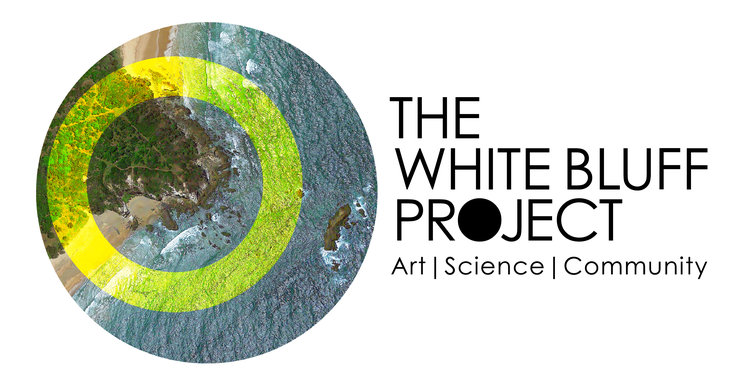White Bluff is the steep pointy terminus of Eastern Australia’s Great Escarpment. Here the extensive forested expanses of the hinterland connect directly with the coast; where a finger-like ridge descends from the mountains and reaches the sea, ending in the crumbling cliffs of White Bluff.
This is where Jurassic forests, travelling through time from the supercontinent Gondwana, meet the southern-most continental coral reefs. Nowhere else can you travel, in such a short distance, from a richly diverse marine ecosystem through fertile coastal plains and tall eucalypt forests to humid subtropical valleys and ranges clad in thick rainforest and finish in a subalpine realm where it snows each winter and the land is covered in ancient Antarctic beech forests.
This incredible transect is filled with an astonishing diversity of plants and animals - many of which find a rare refuge in the small patch of protected land at White Bluff. Here you will still find littoral rainforest, blanketed in salt spray and sheared by wind from the ocean. In that forest stands a lone copse of hoop pines growing at the southern coastal limit of their range. And, in turn, this precious ecosystem is connected through a narrow ribbon of undeveloped dune to the nationally significant South Moonee Forest which supports tall eucalypt and swamp forest and populations of forest fauna species that do not occur so close to the sea elsewhere on the North Coast. White Bluff is an ecological haven; a place where we are custodians of globally significant biodiversity - some of our country’s first and last land.
All this amazing ecology has been brought to life for the White Bluff Project by one of our most passionate and inspiring science collaborators, Ecologist Mark Graham.
Mark has worked across government, industry, and community and within many Aboriginal nations in northern NSW as an ecologist, elected representative, educator and business leader to protect, restore and rebuild country and culture. He is an accomplished educator; over many years in this capacity he has worked to highlight to residents of the region the global significance of the White Bluff land and seascape, in doing so he has provided deep inspiration for many to fight for the protection, maintenance and restoration of the ancient cultures and life-support systems of this incredible area.
“My parents gave me a sense of the land. They would often take my sister and I off into the bush. It’s an amazing landscape to be brought up in because there’s so much of interest and inspiration.”
Mark’s family moved to the Coffs area when he was 4 years old and he has spent most of the ensuing years deepening his relationship with this land. After receiving an Applied Science degree from SCU Lismore he spent more than a decade researching and learning from the north coast environment. From endangered frog research in the Tweed Valley, to conservation assessments and wetlands work for National Parks in Coffs to being the Manager of Natural Resources of the Coffs Harbour City Council, Mark has dedicated his career to the land.
One of the longest-term and greatest accomplishments of Mark’s life has been the collaboration with community and the Gumbaynggirr nation to protect the South Moonee Forest that immediately adjoins White Bluff. This area is the single most important bastion of biodiversity along the Northern Beaches of the Coffs Coast and Mark’s collaboration with Indigenous and non-Indigenous folk in this landscape has resulted in permanent protection of this nationally significant landscape. This landscape now provides myriad opportunities for supporting and rebuilding Indigenous cultural practices and for maintaining and restoring an astonishing natural heritage legacy in a sea of recent urban sprawl.
White Bluff
Mark explains that what remains now at White Bluff, and in the forests of the surrounding hills, mountains and escarpments of the North Coast are assemblages and ecosystems that can trace their history back tens of millions of years.
“The floristic assemblages, so the plants and the general diversity and structure of the ecosystem, the plant biomass, the fungal interconnectedness, the lichens, have irrefutable fossil evidence showing that they occurred back tens of millions of years into prehistory, back to the break up of Gondwana and well before that.
“This is particularly true for the hoop pine dominated ecosystems, of which there is a fair bit on the Dorrigo and Eastern Dorrigo plateau. In places such as Lake Eyre and Patagonia there is readily identifiable fossil deposits (mostly leaves and pollen) showing these ancient assemblages. Some of these forests evolved during the age of dinosaurs and Australia had megafauna until a major extinction event even 20-40,000 years ago. So these forests did have creatures that they no longer have but, the framework of that ecosystem stretches back a long way. If you wound back time, potentially to 50-80 million years ago, what you are seeing and smelling and, to an extent, even hearing with the birds, would be readily recognizable in those prehistoric forests.”
There is even a small stand of hoop pines remaining at White Bluff and they represent the most south-eastern occurrences of this species in Australia and the world. During the project’s fist visit to White Bluff, way back in early 2019, there was true joy and excitement at finding these rainforest trees in such an extremely coastal environment.
“It’s a remarkable thing to consider. We truly are custodians of globally significant biodiversity - some of our country’s first and last land.”











